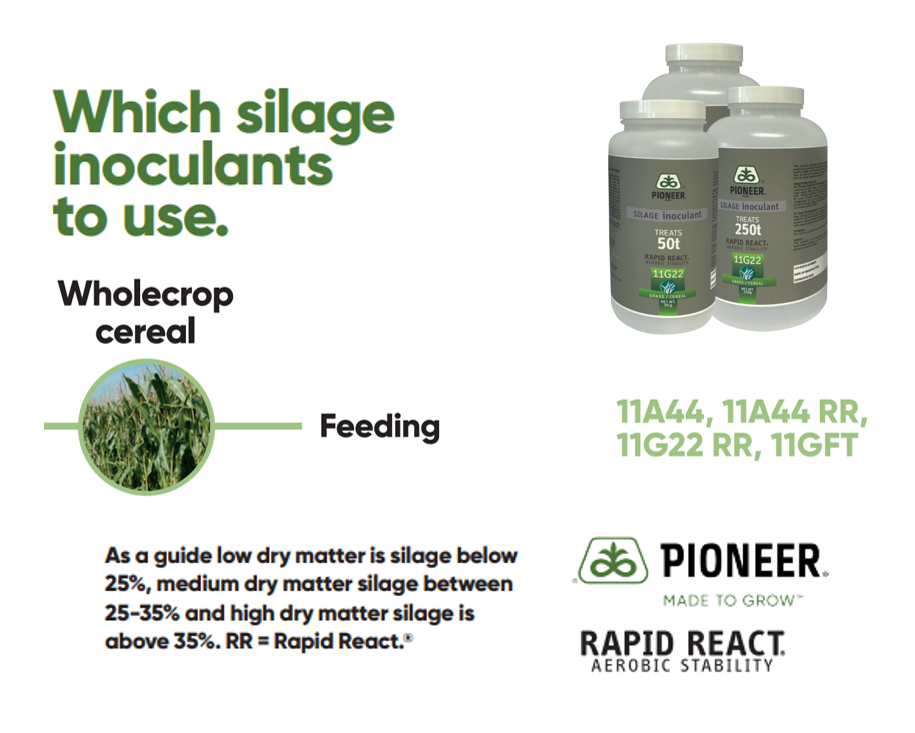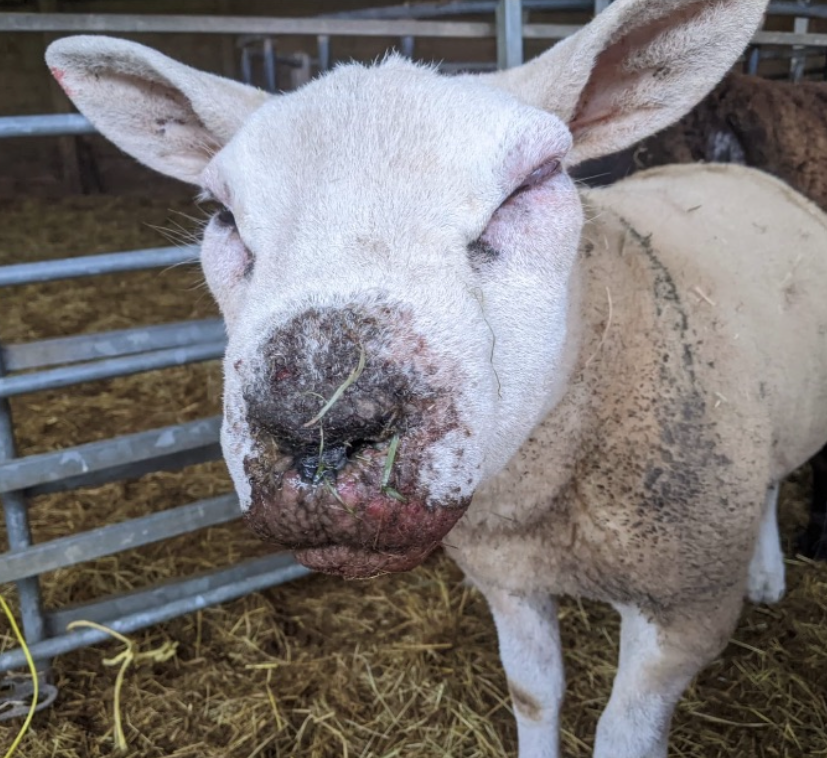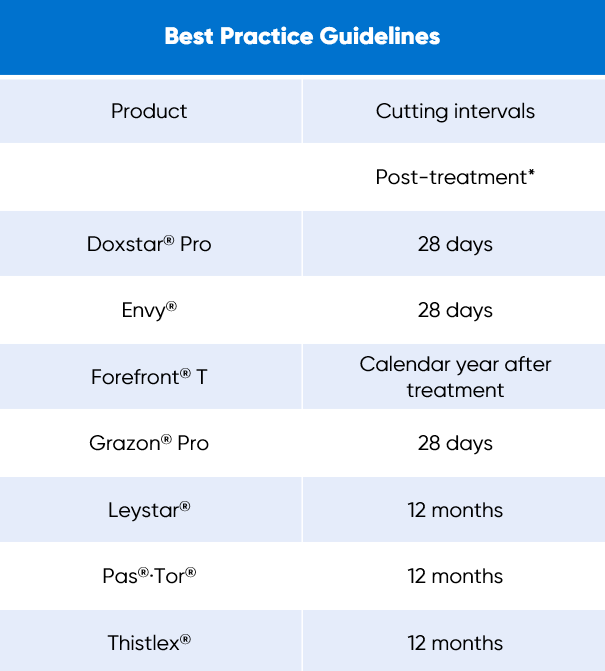|
|
Welcome to the Corteva™ Agriscience
Forage Agronomy Update
These regular technical notes are a seasonal commentary to help those interested in improving grassland and forage productivity on dairy, beef, sheep and equestrian enterprises.
You can claim two CPD points for subscribing to this email update.
|
|
|
|
|
|
Clean up with Forefront T | Wholecrop cereal silage | Safe and proper use of Plant Protection Products | Maximising your maize silage | Management of weeds beyond optimal growth stages | Winter cover crops after maize | Implications of late treatment on ragwort | Thistle species | Thistle control and why it helps contain Orf | Best practice guidelines for reseeding intervals | Leystar and its weed spectrum | FAQs | BASIS and NRoSO CPD points
|
|
|
|
Clean up with Forefront T
|
Use Forefront® T if high population of long-established weeds need to be controlled.
It delivers the highest levels of control of docks, thistles, nettles, ragwort, buttercups and dandelions. It translocates quickly into root systems rapidly causing targeted plants to defoliate, twist and die.
Key usage points:
- At this time of the year, perennial weeds are large and flowering / post flowering so plan to top grazing fields before application.
- Use on fields grazed by cattle or sheep only.
- Keep stock out for 7 days – longer if ragwort plants are present and still visible.
- A single well-timed application of Forefront T can control weeds for up to 18 months.
- Rainfast in 1 hour.
- Use the stewardship feature within the Corteva Forage App to deliver key stewardship guidance to end users.
|

|
|
|
Cutting and fermenting wholecrop cereal silage is a popular way of providing effective, good quality silage. Barley, wheat, oats and triticale crops can all be considered. Crops should be cut just as the grain is starting to turn yellow with the grain itself at the ‘soft cheddar’ stage. This usually occurs about 4-6 weeks before the normal grain harvest date.
Care should be taken to ensure the crop is at the correct growth stage and the dry matter content of the ensile crop does not exceed 40%. In situations where the crop is cut at too late a growth stage or where the dry matter content is above 40% significant dry matter losses and spoilage can occur. Sometimes in good weather dry matter contents can increase very quickly so prompt ensiling is important. Given aerobic spoilage is such a significant risk the use of an additive that can supress such spoilage is often advisable.
The Pioneer range of silage inoculants include specific products that provide proven benefits when applied to wholecrop cereal forages.
- Pioneer Brand 11A44: has a single mode of action – it powerfully supresses the growth of yeasts and moulds in high dry matter silages 3 to 6 weeks after ensiling.
- If you plan to feed the silage soon after ensiling, opt for Pioneer Brand 11A44 Rapid React instead – the same aerobic stability can be achieved in 1 week.
- Pioneer Brand 11G22 Rapid React can create stable silage soon after ensiling but also improve the efficiency of the lactic fermentation, often refereed to as the ‘front end’ of the fermentation process. This front end assistance leads to a more palatable silage.
- Pioneer brand 11GFT is a unique bacterial product which generates an enzyme that improves fibre digestibility, whilst also helping the front end and reducing aerobic stability.
|

|
Safe and proper use of Plant Protection Products
|
The Health and Safety Executive (HSE) is gearing up farm visits to assess compliance with the Official Controls (Plant Protection Products - PPP) Regulations 2020 (OCR). It’s likely that livestock farms will have a focus. Here are the key areas of emphasis during these inspections:
- PPP storage: One of the crucial aspects under scrutiny will be the storage of PPPs. This includes the assessment of storage conditions and inventory management, including the containment measures in place.
- Training and safe usage: The proper training for the safe storage and application of PPPs will be assessed to ensure that farm personnel have the necessary knowledge and skills for handling these products.
- Mixing and disposal: The inspection will also cover the mixing and disposal of PPPs, which includes the management of diluted solutions and the disposal of washings.
- Spillage protocols: The inspection team will evaluate how farms deal with PPP spillages to prevent harm to the environment and human health.
- Machinery calibration and maintenance: Ensuring that the machinery used for PPP application is calibrated, maintained properly, and compliant with the National Sprayer Testing Scheme (NSTS) standards, along with accurate record-keeping.
- PPP Selection and Personal Protective Equipment (PPE): Assessing whether the correct types of PPPs are selected for specific applications and if the appropriate Personal Protective Equipment (PPE) is being used.
- Record keeping: Verification of proper record-keeping procedures, including maintaining comprehensive records of PPP application.
- Contractor oversight: Oversight of any contractors involved in PPP application and their respective record-keeping.
- Local environmental risk assessment for pesticides (LERAP): Ensuring that farms are compliant with LERAP regulations, particularly with regard to buffer zones, protection of watercourses, Sites of Special Scientific Interest (SSSI), and adequate record-keeping. Scientific Interest (SSSI), and adequate record-keeping.
|
Maximising your maize silage
|
With many maize crops establishing well it is worth planning ahead and considering what the ideal silage inoculant might be. Pioneer inoculants are able to improve the efficiency of the acid fermentation, reduce heating, and raise fibre digestibility.
Select the one that fits your maize needs:
|

|
Management of weeds beyond optimal growth stages
|
As perennial weeds reach maturity and start to produce seed heads, they increasingly focus the translocation of photosynthates to reproduction and less into root structures.
Docks can also be shredded at this time of the year as dock beetles emerge in numbers and chew through dock leaves leaving a skeletal like leaf structure that is not suitable for spraying.
Consequently, the ability of a grassland herbicide to deliver an effective root kill is reduced so in grazing pastures plan to top these weeds and spray once sufficient re-growth has occurred and docks are 150-250mm across or high (about the size of a dinner plate) and then spray with Doxstar® Pro.
|

|
Winter cover crops after maize
|
Principal® Forte and Dragster® are two NEW wide spectrum grass and broad-leaved weed herbicides. Their introduction resonates as both products control a wide range of weeds and have few following crop restrictions: a feature that is increasingly valued as farmers are encouraged to establish winter cover crops with the Sustainable Farming Incentive SOH4 with payment of £203 / ha / year. Their use this year has shown both solutions to deliver good effective weed control, with no variety selectivity issues (both products contain the crop safener isoxadifen) and a wide spectrum of weeds species so there is less need for more complicated tank mix programs.
- Principal Forte contains 510 g/kg of dicamba + 62 g/kg of nicosulfuron + 31 g/kg of rimsulfuron and 31 g/kg isoxadifen safener. It is applied at 480 g / ha. The pack size is 2.4 kg so each pack treats 5 ha. Apply from 2 to 9 leaves unfolded (BBCH 12-19) between 1st May and 31st July.
- Dragster contains 148.15 g as/kg rimsulfuron + 92.6 g as / kg thifensulfuron-methyl + 111.1 g/kg isoxadifen safener. The pack contains 405 g of product so each pack treats 3 ha. Apply from 3 to 8 leaves unfolded (BBCH 13-18) between 1st May and 31st July.
For weed lists and more details on use, go to the Corteva Forage App, select 'Weed Control' and then 'Products & Labels'.
|

|
Implications of late treatment on ragwort
|
Forefront® T is by some margin the best herbicide to use on ragwort in fields grazed by cattle or sheep. At this time of the year ragwort plants are flowering. It is best to delay any treatment until after they have been topped and any resulting regrowth comes through to form a new rosette plant.
Treated at the rosette stage, ragwort will senesce more quickly, enabling stock return sooner.
Grazing animals should be excluded from treated areas until any ragwort has completely recovered or rotted down and there is no visible sign of the dead weed. Below is the ideal growth stage to target.
|

|
|
|
There are many species of thistle, below we detail the main features of 6 species.
- Creeping thistle: spreads primarily by vegetative growth of roots, root fragments can remain viable for several years, its flower heads are purple/pink in colour.
- Spear thistle: has a large tap root (up to 70cm long), grows from seed, and seed dispersed by wind can travel up to 30m. Flower heads consist of pink florets and a ball of spiny bracts.
- Marsh thistle: the whole stem is spiny, flowers are usually purple, plants can grow up to 1.2m tall.
- Meadow thistle: a slender plant, it can grow up to 80cm tall, its stem is hairy, and the plant only produces one pink/purple flower head.
- Musk thistle: plants can grow up to 1.5m tall, the pink flower heads tend to overhang and are surrounded by spiny bracts.
- Slender thistle: a tall, slender plant with small pinkish flower heads, spiny wings cover the whole of the stem.
Treat when thistles are at the vegetative ‘rosette’ stage, 150mm-250mm across or high, use the spray timing indicator in the Corteva Forage App to identify the ideal growth stage. Herbicides containing either aminopyralid or clopyralid will give control of all thistle species. When thistles are the main target, use Thistlex®. If other weeds are also present, use Forefront® T, Pas®·Tor® Agronomy Pack, or if using a knapsack Grazon® Pro or Grazon® Spot.
|

|
Thistle control and why it helps contain Orf
|
Grassland management and the control of weeds, particularly thistles, is one way to prevent the spread of orf through your livestock. When grazing close to thistles, the spines can traumatise the skin allowing the orf virus to infect your sheep.
Where thistles dominate, spray with Thistlex® using a tractor mounted or self-propelled sprayer. If the area infested by the thistles is less than 5%, spot treatment with Grazon® Spot or Grazon® Pro will be more cost effective. All these products will control all species of thistles including spear, creeping, and marsh. Tackling them now reduces the number of new plants that will germinate from seed this year.
|

|
Best practice guidelines for reseeding intervals
|
Reseeding is an important part of grassland management, but you’ll gain the most benefit from your investment with effective weed control.
|
|
|
|
|
|

|
*Please read the label to check for any special cultivation requirements.
|
|
|
|
|
|

|
*1) To allow maximum translocation to the weed roots and biomass decay and/or 2) To meet label requirements.
|
|
|

|
*1) In the absence of ragwort. 2) Allow 14 days if a high population of buttercup has been treated.
3) To allow maximum translocation to the weed roots (shorter period than normal cutting interval of 28, as it is unlikely that cattle will damage all treated weeds in the immediate way that cutting does) and biomass decay.
|
Leystar and its weed spectrum
|
Many newly sown leys will be established in the next few week. Control weed seedling weeds once they emerged. If clover is not present then use Leystar® at 1 L/ha. It is very safe to grass and controls a wide weed spectrum, including chickweed, charlock, knotgrass, mayweeds, seedling docks and thistles.
Key points to note on use:
- Apply to weeds which are small and actively growing.
- Do not use on grassland that will be cut for animal feed, fodder or bedding nor for mulching or composting within 12 months of treatment.
- Applications on newly sown leys can be made up until the 31st August.
|

|
|
|
Q: Can Grazon® Pro be applied through a weedwiper?
A: No, none of our grassland herbicides have approval for this application method.
A: It delivers susceptible level of control of chickweed, dandelion and cranesbill.
Q: Which product controls Burdock?
A: Doxstar Pro will provide moderate control of Burdock (Arctium minus) as well as nettle and yarrow.
Q: Have you got a simple decision tree which identifies the best selective herbicide to use for a range of grassland weed problems?
A: Yes – It is available in the Corteva Forage App. Click on weed control, select “Grassland Herbicide Decision Map.”
Q: What PPE must I wear when spraying Corteva herbicides that have an approval for knapsack application?
A: You must wear a coverall, gloves and boots when spraying. When handling concentrate, you must also wear face protection (a face shield).
|
BASIS and NRoSO CPD points
|
2 BASIS points (1 crop protection and 1 personal development) will be awarded to those subscribing to the Forage Agronomy Update.
2 NRoSO points will be awarded for subscribing.
To receive your CPD points subscribe to the Forage Agronomy Update by clicking here.
|

|
Use plant protection products safely. Always read the label and product information before use. For further information including warning phrases and symbols refer to label. ®™ Trademarks Corteva Agriscience Limited and its affiliated companies. All other brand names are trademarks of other manufacturers for which proprietary rights may exist. All manufacturers trade names and trademarks are duly acknowledged. © 2024 Corteva. Forefront® T contains aminopyralid and triclopyr. Doxstar® Pro contains fluroxypyr and triclopyr. Principal® Forte contains nicosulfuron, rimsulfuron, dicamba and isoxadifen. Dragster® contains rimsulfuron, thifensulfuron and isoxadifen. Thistlex® contains clopyralid and triclopyr. Pas®·Tor® contains clopyralid, fluroxypyr and triclopyr. Grazon® Pro/Spot contains clopyralid and triclopyr. Envy® contains fluroxypyr and florasulam. Leystar® contains fluroxypyr, clopyralid and florasulam.
|
|
|
|
|